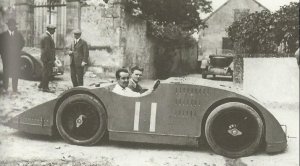Simanaitis Says
On cars, old, new and future; science & technology; vintage airplanes, computer flight simulation of them; Sherlockiana; our English language; travel; and other stuff
BUGATTI RAILCARS
IT’S THE Great Depression, fabulous Royale luxury cars are glued to the Molsheim showroom floor, and there’s a surfeit of the Royale’s 12.76-liter six-cylinder powerplants. What is one to do?
Being Ettore Bugatti, one thinks big: Why not design the Bugatti of railcars and power each with four Royale engines?
And, indeed, this is what he did.

A Bugatti pair, ca. 1938, a Type 57 sedan and a railcar. Poster by R. Geri. Image from Bugatti Legend Exhibition, July 1- September 12, 1993, Luca Gentili Editore, 1993.
The Bugatti railcar made its debut in 1934 on the Paris-Deauville route, continuing a short distance beyond to the resort town of Cabourg on the English Channel. The 134-mile trip was accomplished in two hours, though the Bugatti railcar was capable of considerably more speed than this 67-mph average might suggest.
In early tests between Paris and Chartres, Jean Bugatti, Ettore’s son and also a talented designer, was asked to keep it below 90 km/h (56 mph) because of track conditions. On his first test, he went 125 km/h (78 mph).
Later, on a railway stretch outside Le Mans (what a fitting location!), the Bugatti railcar set a world speed record of 173 km/h (107 mph), later to rise to 196 km/h (122 mph). In regular service, Bugatti railcars cruised at around 90 mph.
Bugatti built a total of 86 railcars between 1933 and 1938, plus two more after World War II. Some served the Paris-Deauville western route; others traveled south from Paris to Vichy and Lyon; still others ran east to Strasbourg and Bugatti’s own hometown of Molsheim.

Above, a single Bugatti railcar. Below, a triple. This and other images from Bugatti Magnum, by Hugh Conway and Maurice Sauzay, Motorbooks International, 1989.
Some of these were single railcars; some were doubles with an added (unpowered) carriage car; others were triples with carriage cars both fore and aft of the railcar.

The engineer’s elevated cabin. Controls image below from Mike’s Railway History, http://goo.gl/RynLHo.
The engineer sat in an elevated cabin located midway in the railcar. His work station included separate controls for each of the four engines (center), their rev counters, a lever for pneumatic braking (upper right) and a crank for cable-operated brakes (lower center).
The engineer’s location gave him a commanding view with a single or double configuration, but woefully little knowledge of the front of a triple’s forward carriage car. With a triple, he depended on a crew member up front for help in station maneuvering and shunting. This fellow used hand signals to communicate and, for an emergency, could also signal with a small detonation device. In fact, he was known as a detonation man, an homme-pétard.
The railcar’s sleek lines were influenced by Bugatti’s 1923 Type 32 race car, nicknamed the Tank de Tours after the venue of that year’s French Grand Prix.
Like the Tank, the railway car had an airfoil shape with flat sides. The race car’s airfoil affected handling because it generated lift at speed. The railcar avoided this with “road-holding weight,” in its case, 40 tons. In fact, the contours tended to displace the air upward, to the benefit of the railcar’s interaction with other trains on adjacent tracks.
First-class passengers sat 2 +1 in lavish surroundings; those in second class sat 2+2 on cleverly designed seats, the cushions and backs of which could pivot to change the direction of view.
In a classic example of racing improving the breed, each of the railcar’s four Royale powerplants delivered between 215 hp (on a gasoline-benzole blend) to 225 hp (gasoline-benzole and a hit of ethyl alcohol) to a maximum 255 hp (gasoline-benzole with a full dose of the alcohol), all at 2500 rpm.
Fuel economy wasn’t a long suit: around 1.1-liter/km (less than 0.5 mpg). In fact, it was cited that 70 percent of operating costs were for fuel and oil, compared with only 4.5 percent for maintenance and overhaul.
Bugatti never considered diesel power, but he did investigate steam, a train à vapeur variation. Matters got as far as powerplant development, but World War II precluded anything further.

The first Bugatti railcar, the Presidential, resides in the Cité du Train Mulhouse (see www.citedutrain.com/en). Image by ignis.
The Bugatti railcar remains a wonderfully appropriate way to celebrate a surfeit of 12.76-liter 8-cylinder Royale engines. ds
© Dennis Simanaitis, SimanaitisSays.com, 2015





When I was a child, we used to travel in those Bugatti “autorails” as they were called, every day to go to school between Cannes and Nice. Of course at that time I have no idea that they had been built by Bugatti…
I think they remained in service until 1961 or 1962 in some isolated regions, until replaced first by “Michelines”, other “autorails” built by Michelin, then some larger Alsthom-built diesel-electric, then full electric stuff.
Philippe, interesting context, thank you. As we ponder “full electric” cars what is your guess on percent of rail propulsion – passenger and freight – that is full electric in Europe? It would seem quite different from North America.
Very interesting story about this charismatic engine. I wasn’t aware surplus engines were used in railcars. But mention of the gorgeous Bugatti Royale reminded me of a feature in an issue of Road &Track where the 6 original Royales were gathered on the lawns of Pebble Beach. Beautiful sight. In ’78 I saw the Royale at the Ford museum in Detroit and years later the 3 Royales at the museum in Mulhouse. One of the 3 was the 7th Royale of which only the chassis had been made before Bugatti closed down the Royale programme, but now it has been completed with coachwork and all. The museum is definitely worth a visit if you are anywhere near the north-eastern part of France even if you are not a dedicated car nut.